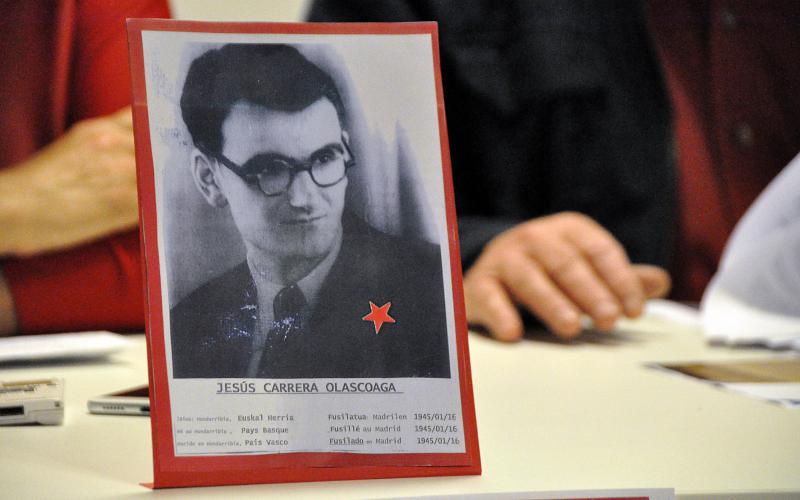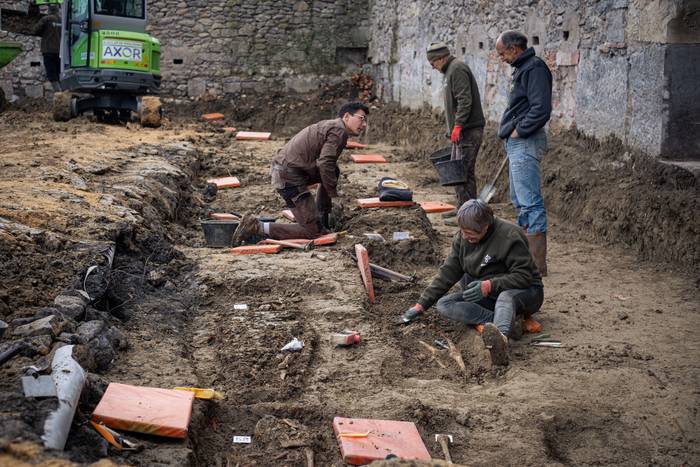"Wolframarena was the contraband of the elite."
- Arburua, rooted in the Bidasoa, has investigated the smuggling of its environment over the past 20 years. Last year, ‘Wolframio. He published the essay ‘Smuggling between dictators’.

He has begun his essay on the relationship between Wolframio and Elhuyar.
The whole story began with the Elhuyar brothers two centuries earlier. In Bergara they were the ones who isolated the properties of the tungsten and discovered the properties of this mineral: it is very hard and has a very high melting point. These Elhuyar brothers were very famous around the world because of this discovery.
Therefore, the essay begins with an account from the Basque Country, approaches the Galician and Portuguese mines, and then we return to the Basque Country to talk about smuggling. It's interesting because it's totally unknown, I've been researching for 20 years the smuggling and the works of these environments, and now I've learned from it.
What peculiarity does the tungsten have in order to be so unknown its smuggling?
I studied the old smuggling, which many of us have heard at home. Smuggling of punches or liqueurs. It's all been an evolution in my life and my research. I don't remember who very well, but I heard that it was a tungsten smuggling at Irun. I didn't know what it was, and I started tracking, but I didn't find any testimonies, a couple or just, and they talked too much about it, they didn't want to talk too much. I left the research for a while, then I recovered it… I found nothing in Irun’s files. One day I was wrong to sign up for the Spanish Ministry of Foreign Affairs and I found a tremendous treasure.
In fact, the Allies repeatedly denounce the smuggling of tungsten in 1944 and affirm that on 2 May of that year the Spanish Government signed an agreement with the Allies, saying that it was not sold to the Germans for three months [this mineral was essential for the Nazi production of its armory]. However, although they remained so for three months, they later determined the sale of an amount. If not, the allies threatened the then Government of Spain not to sell oil if Spain sold during those months tungsten. So that agreement was signed, but from there the allies repeatedly denounced the mineral smuggling.
You have received that the tungsten that Spain had left Galicia. From there he arrived in Euskal Herria in contraband at the same time. Why did they go around here?
They were going through here because there were Nazis in Hendaia, so it was a very easy road. They also went through Canfrance, but here was the shortest road. In addition, the higher authorities promoted a network to make the mineral as easy as possible.
They were aware of what the smuggling was doing in all the houses that were being practiced, but you told them they didn't have the tungsten. Only because of the weight of the pact?
Passing the tungsten was breaking a high-level agreement, and the other smuggling was ultimately for the benefit of many. For example, some elements for the start-up of the factories passed through the other side of the Bidasoa. It was banned, but there was also an interest in starting the factories.
The Wolframian was totally illegal, and it can be said that it was a contraband of another level, as a matter of state. This smuggling was driven by supporters of the Franco regime. I was very silenced, a lot of people didn't participate and a lot of money moved. I've asked the old smugglers if they knew that an anti-smuggler was being made, and they received with an absolute surprise what I was asking them. It was an elite smuggling, although from Portugal to Galicia or to Spain. It is true that the people of the town participated in this, but it was very closed. No mention has been made of this.
In the test you can also see pictures of the warehouses. Where did they keep the tungsten?
They kept it mostly in some warehouses in Irun. Documents show over and over again a warehouse called Marion, which was one of the most important. The essay also states that in numbers 6 and 8 of Bizente Elizegi Street of Renteria-Orereta there was a tungsten deposit called Renteria de Storeen alema. In general, they brought from Galicia in trucks and then deposited them in the warehouses here, among other products. Sometimes it was also directly by train. They also spent it in boat, and so they caught an Iraqi.
In Bidasoa there has always been smuggling, but in his works he has worked especially during the Franco era.
I've heard a lot about smuggling at home, I think transmission is very important. I found out about smuggling in a very natural way. Night work. In 2011, I published the book El contrabando en la zona del Bidasoa, and in one of its chapters I talked about smuggling, but I heard at home that the Bidasoa has always been done. But what is it always? Then I did a monograph and studied from when it was done in the first part; apparently, the Romans, when they were here, put a few arrows to pass products on the Bidasoa from one side to the other, and then it seems that it was also done.
In the second part, I studied what was done after the 1936 war and searched for testimonies. For example, I was with a group of Behobia women who were very strong in smuggling, from Behobia to Pausu or from San Juan de Luz. And it's that women also participated.
Women often do not appear reading the story, and you mentioned that they were part of the history of smuggling.
I don't think there's been a machismo about smuggling. I think smuggling, in our environment, and other than tungsten, has been very community, inclusive. In short, after the war of 1936 almost all participated, that is, children, civil guards, animals… Women, it is true, acted differently. Many did so when they were in charge, or even from inside the house, collaborated in the placement of a white Sábano to warn of the passage of the civil guards. Women also frequently took part in the Portuguese Pass. The smugglers in Behobia to whom I referred earlier were first-class smugglers, including a group and also organised for conciliation.
They were all accomplices to smuggling. Where was the underground?
Smuggling is carried out if the products pass over the border in order not to pay taxes or because the product is prohibited. In addition, the sale of these products was a smuggling. Today, for example, the passage of alcohol, drugs, weapons, exotic animals, etc. is prohibited. For example, some exotic animals have recently been detected at Foronda airport. This is smuggling that goes underground.
She has also worked on the migration of Portuguese in the vicinity of the Bidasoa River. Would you call him smuggling?
Many people call it mafia. For me, the mafias are members of the government. After all, people have to go through a state, because they have no jobs, or because they are in misery. So who causes it? Who makes them not live in peace? Who causes total uninhabitability? That is the responsibility of governments. It's true that it's a smuggling because they were collecting money, and now they're also getting money with migrants. Yes, money is received, as with other contrabands.
In short, there is a need there and without help it is often difficult to cross the Bidasoa. On one occasion a Portuguese told me that for the first time he was passing through Bera, but he was captured and until he arrived in Portugal he was in different jails. However, he said he was going to France because there was work there, but he used the phrase: ‘I’ll go with professionals’. I mean, it was going to happen with smugglers. He complied with what was said and accompanied a pin. He said it was the best investment made in his life. It is also true, and we should not avoid that, that there were passers who did their job very badly. There are also dark anecdotes, and those people knew who they were in the villages. I would say that the Portuguese was an exodus, as one million people fled when they lived 10 million in that country. The vast majority passed without paper, as now. I see great similarities between Portuguese and current migration. I'm researching raiders, to see if their nature has changed from one time to another. There I am.
Bilbo, 1954. Hiriko Alfer eta Gaizkileen Auzitegia homosexualen aurka jazartzen hasi zen, erregimen frankistak izen bereko legea (Ley de Vagos y Maleantes, 1933) espresuki horretarako egokitu ondoren. Frankismoak homosexualen aurka egiten zuen lehenago ere, eta 1970ean legea... [+]
Deportazioaren Memoriarako Euskal Koordinakundeak aintzat hartu nahi ditu Hego Euskal Herrian jaio eta bizi ziren, eta 1940tik 1945era Bigarren Mundu Gerra zela eta deportazioa pairatu zuten herritarrak. Anton Gandarias Lekuona izango da haren lehendakaria, 1945ean naziek... [+]
Pamplona, 1939. At the beginning of the year, the bullring in the city was used as a concentration camp by the Francoists. It was officially capable of 3,000 prisoners of war, at a time when there was no front in Navarre, so those locked up there should be regarded as prisoners... [+]























